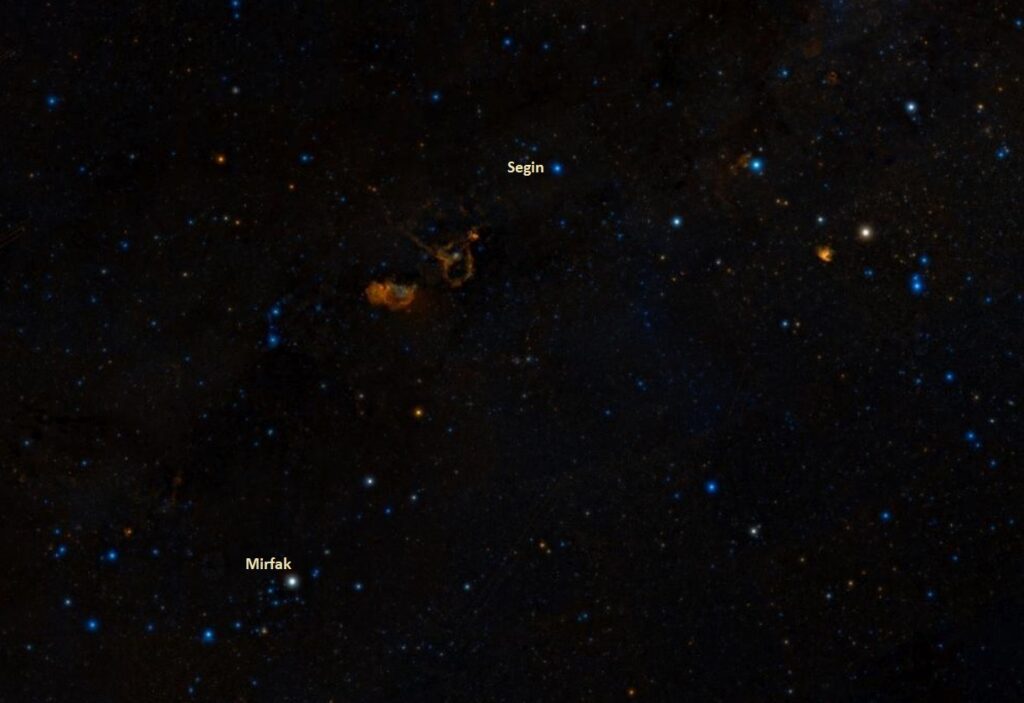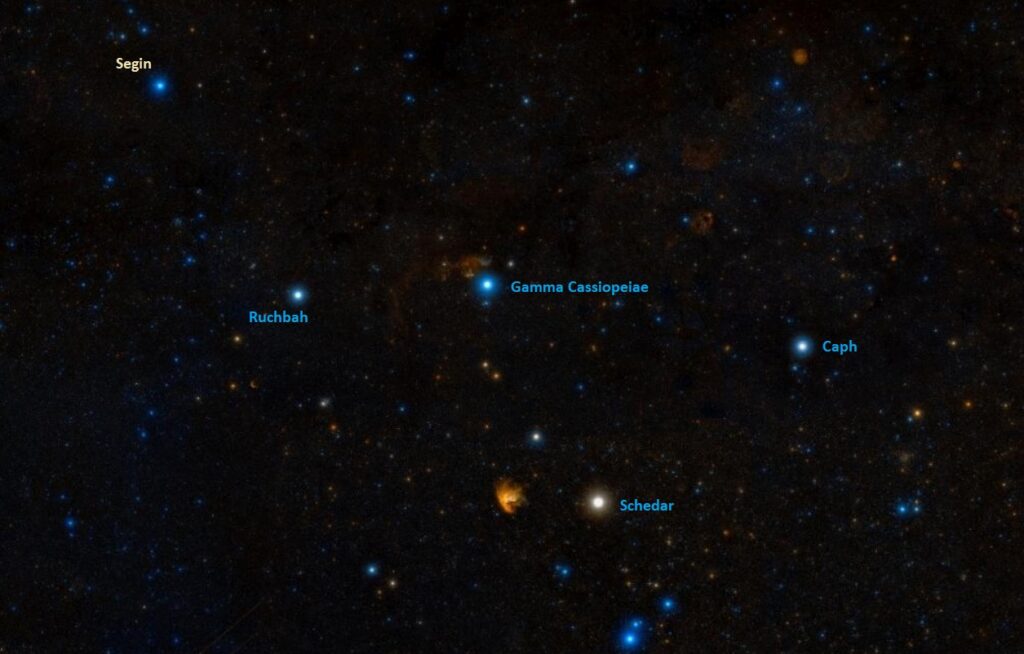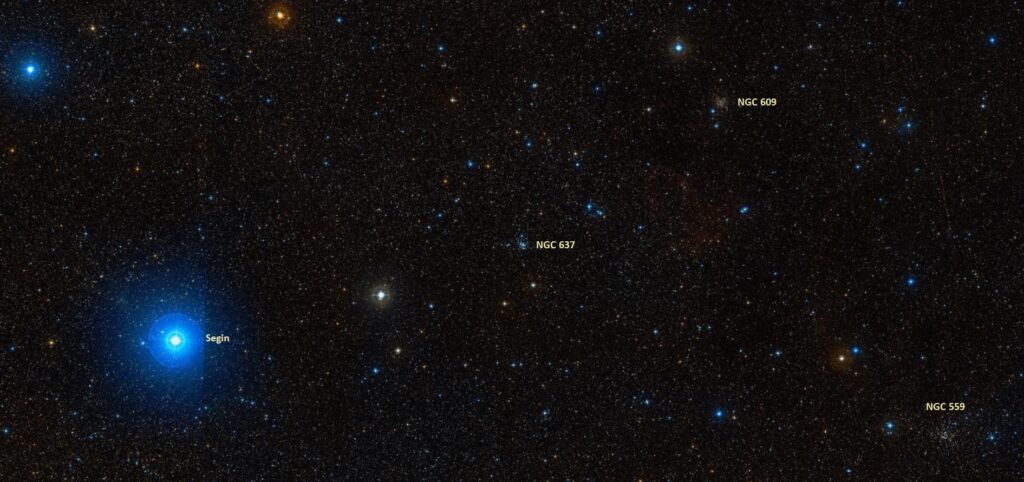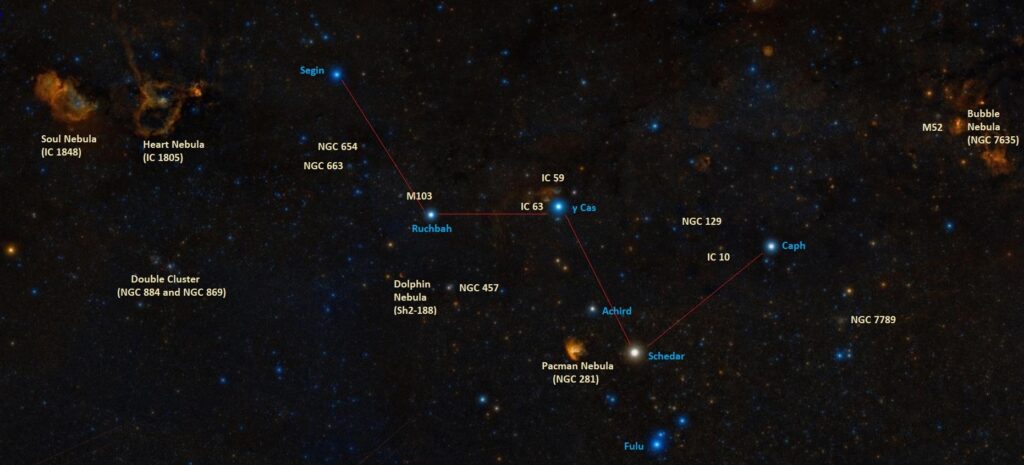Segin, Epsilon Cassiopeiae (ε Cas), is a blue-white star located in the constellation Cassiopeia. With an apparent magnitude of 3.37, it is the constellation’s fifth brightest star, after Gamma Cassiopeiae, Schedar, Caph and Ruchbah. Segin lies at an approximate distance of 410 light years from Earth. It is the faintest of the five stars that form Cassiopeia’s W.
Star type
Segin has the stellar classification B3 V, indicating a main sequence star still fusing hydrogen in its core, appearing blue or blue-white in colour. It is sometimes classified as a giant star of the spectral type B3 III.
Segin has a mass about 9.2 times that of the Sun and a radius 6 times solar. The radius is derived from the interferometrically measured angular diameter of 0.43 milliarcseconds.
With an effective temperature of 15,174 K, Segin shines with 2,500 solar luminosities. It has a projected rotational velocity of 30 km/s. Its estimated age is 15.4 million years.
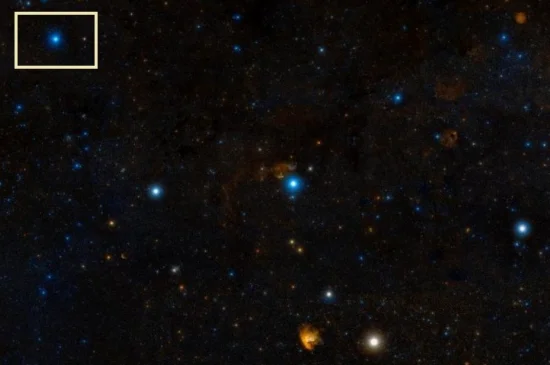
Segin (Epsilon Cassiopeiae), image: Wikisky
A study published in 1993 listed Segin as one of the known Be stars without an “e” or “shell” classification in the Bright Star Catalogue. Be stars are class B stars with lines of hydrogen in their spectra, indicating the presence of a circumstellar disk of gas ejected from the star.
Hipparcos measurements in the early 1990s suggested that Segin may be slightly variable. The star’s brightness varies with an amplitude of 0.0025 over a period of 2.15 hours.
Hipparcos observations also placed the star in the disputed Cassiopeia-Taurus (Cas-Tau) moving group, suggesting a likelihood of 93% that it is a member. The association may be physically related to the Alpha Persei Cluster as they share a similar velocity and distance. A study published in 1999 confirmed Mirfak (Alpha Persei) to be a member, which suggests that the Cas-Tau association, including Segin, was separated from the Alpha Persei Cluster through tidal interactions over time.
Facts
Segin forms Cassiopeia’s W with Ruchbah (Delta Cassiopeiae), Gamma Cassiopeiae, Schedar (Alpha Cassiopeiae) and Caph (Beta Cassiopeiae). The asterism appears as a W during the northern hemisphere spring and summer. It appears inverted during the northern winter months and when seen from locations south of the equator.
Of the five stars, Gamma Cassiopeiae is the only one that is hotter (25,000 K), more massive (17 solar masses), more luminous (34,000 solar luminosities), and younger (8 million years) than Segin. Even though it is the second most luminous of the W stars, Segin is the faintest because it is also the second most distant. Only Gamma Cassiopeiae is more distant, lying about 550 light years away. Schedar, Caph, and Ruchbah are much closer to us, at 228, 54.7, and 99.4 light years respectively.
Name
The origin of the name Segin (pronunciation: /ˈsɛɡɪn/) is uncertain. It may be a mistranscription of Seginus, another name with an uncertain origin, which now formally applies to Gamma Boötis.
The name was officially approved by the International Astronomical Union’s (IAU) Working Group on Star Names (WGSN) on September 5, 2017.
Epsilon Cassiopeiae once shared the name Ruchbah with Delta Cassiopeiae, which has kept the name.
In Chinese astronomy, Segin is known as 閣道二 (Gé Dào èr), the Second Star of Flying Corridor. The Chinese Flying Corridor asterism is formed by Segin with Iota Cassiopeiae, Ruchbah (Delta Cassiopeiae), Theta Cassiopeiae, Nu Cassiopeiae, and Omicron Cassiopeiae. The asterism is part of the Legs mansion, which represents the tail of the White Tiger of the West.
Location
Segin is very easy to find because it is part of Cassiopeia’s W, one of the most familiar star patterns in the northern sky. Segin is the leftmost star of the W.
The star can be used to find several bright deep sky objects that lie in the same area of the sky. The open clusters NGC 637 (mag. 8.2), NGC 609 (mag. 11) and NGC 559 (mag. 9.5) appear just west of the star.
Two bright, large and well-known deep sky objects lie east-southeast of Segin: the neighbouring emission nebulae IC 1805 and IC 1848, better known as the Heart and Soul nebulae, and the neighbouring open clusters NGC 869 and NGC 884, also known as the Double Cluster. The Heart and Soul nebulae lie in Cassiopeia and the Double Cluster is in the constellation Perseus.
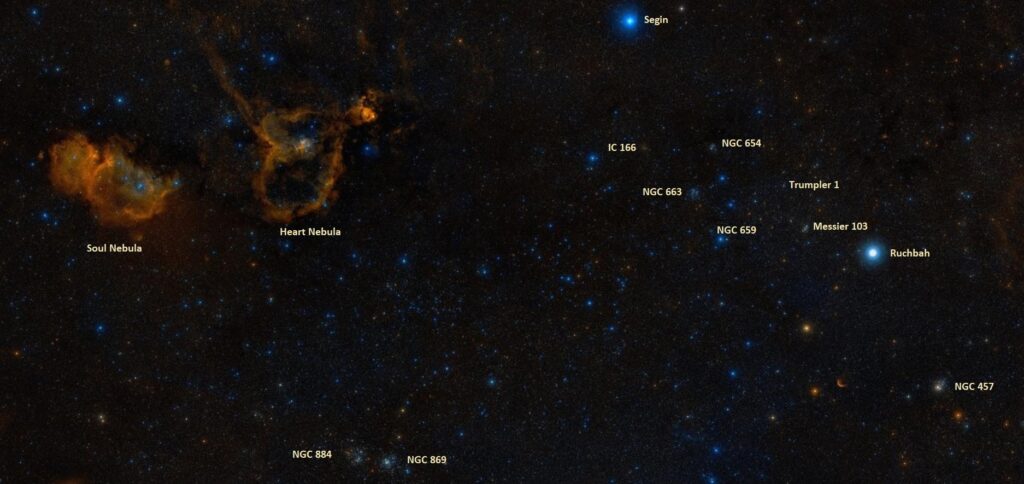
Segin, Ruchbah, the Heart and Soul Nebulae, the Double Cluster, NGC 654, NGC 663, NGC 659, Trumpler 1 and Messier 103, image: Wikisky
The region between Segin and Ruchbah, the bottom left star of the W, contains several other bright open clusters: Messier 103 (mag. 7.4), IC 166 (mag. 11.7), NGC 663 (mag. 7.1), NGC 659 (mag. 7.9), NGC 654 (mag. 6.5), and Trumpler 1 (mag. 8.1).
Constellation
Segin is located in the constellation Cassiopeia. Cassiopeia is one of the most recognizable northern constellations, with its five brightest stars forming a distinct W. It is one of the several northern circumpolar constellations, visible throughout the year from northern latitudes. Along with other constellations associated with figures from Greek mythology, it was first listed by the Greek astronomer Claudius Ptolemy in his Almagest in the 2nd century CE. It is the 25th constellation in size, with an area of 598 square degrees.
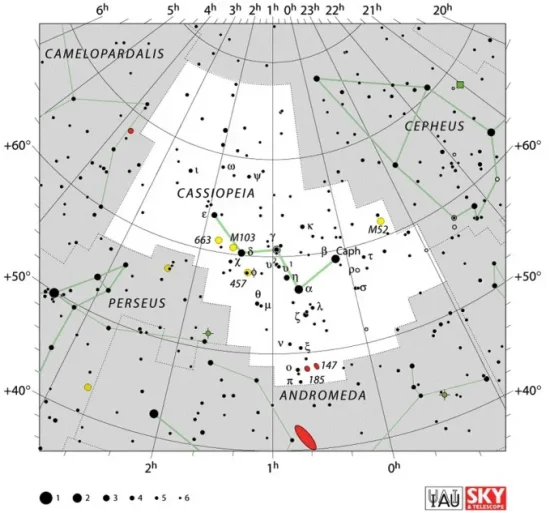
Cassiopeia constellation map by IAU and Sky&Telescope magazine
Cassiopeia is part of the Perseus family of constellations, associated with the myth of Perseus. The group also includes the nearby constellations Perseus, Andromeda, Cepheus, Pegasus and Cetus.
The constellation contains a number of interesting stars, among them the variable yellow hypergiants V509 Cassiopeiae and Rho Cassiopeiae, the bright eruptive variable star Gamma Cassiopeiae, a prototype for its own class of variables, Omicron Cassiopeiae, a Gamma Cassiopeiae variable, the variable blue supergiant Kappa Cassiopeiae, and Pearce’s Star, designated AO Cassiopeiae, an eclipsing binary system composed of two exceptionally massive O-type stars in a close orbit, distorted by mutual interaction.
Cassiopeia is also home to the supernova remnants Cassiopeia A, the brightest radio source in the sky outside the solar system, and Tycho’s Supernova, the remnant of a Type Ia supernova (SN 1572) that peaked at magnitude -4 in November 1572.
Bright deep sky objects in the constellation include the emission nebulae IC 1805 and IC 1848 (the Heart and Soul nebulae), NGC 281 (the Pacman Nebula), NGC 7635 (the Bubble Nebula), the irregular galaxy IC 10, a starburst galaxy in the Local Group, and the bright open clusters Messier 52, Messier 103, NGC 663, NGC 654, the E.T. Cluster (NGC 457), and the White Rose Cluster (NGC 7789).
The best time of year to see the stars and deep sky objects of Cassiopeia is during the month of November, when the constellation is prominent in the evening sky. The entire constellation can be seen from locations between the latitudes 90° N and 20° S.
The 10 brightest stars in Cassiopeia are Gamma Cassiopeiae (mag. 1.6 – 3.0), Schedar (Alpha Cas, mag. 2.24), Caph (Beta Cas, mag. 2.28), Ruchbah (Delta Cas, mag. 2.68), Segin (Epsilon Cas, mag. 3.37), Achird (Eta Cas, mag. 3.44), Fulu (Zeta Cas, mag. 3.66), 50 Cassiopeiae (mag. 3.95), Kappa Cassiopeiae (mag. 4.16), and Theta Cassiopeiae (mag. 4.334).
Segin – Epsilon Cassiopeiae
| Spectral class | B3 V or B3 III |
| Variable type | Periodic |
| U-B colour index | -0.62 |
| B-V colour index | -0.15 |
| Apparent magnitude | 3.37 |
| Absolute magnitude | -2.19 |
| Distance | 410 ± 20 light years (126 ± 7 parsecs) |
| Parallax | 7.111 ± 0.3688 mas |
| Radial velocity | -8.30 km/s |
| Proper motion | RA: +32.982 ± 0.470 mas/yr |
| Dec.: -19.232 ± 0.574 mas/yr | |
| Mass | 9.2 ± 0.2 M☉ |
| Luminosity | 2,500 L☉ |
| Radius | 6 R☉ |
| Temperature | 15,174 K |
| Age | 15.4 ± 3.0 million years |
| Rotational velocity | 0 km/s |
| Surface gravity | 3.5 cgs |
| Constellation | Cassiopeia |
| Right ascension | 01h 54m 23.7261769782s |
| Declination | +63° 40′ 12.372216932″ |
| Names and designations | Segin, Epsilon Cassiopeiae, ε Cas, 45 Cassiopeiae, HD 11415, HR 542, HIP 8886, SAO 12031, FK5 63, BD+62 320, ALS 16380, CSV 100141, GC 2289, GCRV 1052, PPM 13322, UBV 1872, IRAS 01508+6325, JP11 546, PLX 388.00, 2MASS J01542373+6340123, TYC 4036-2834-1, AAVSO 0147+63, Gaia DR2 511974502719733376 |
